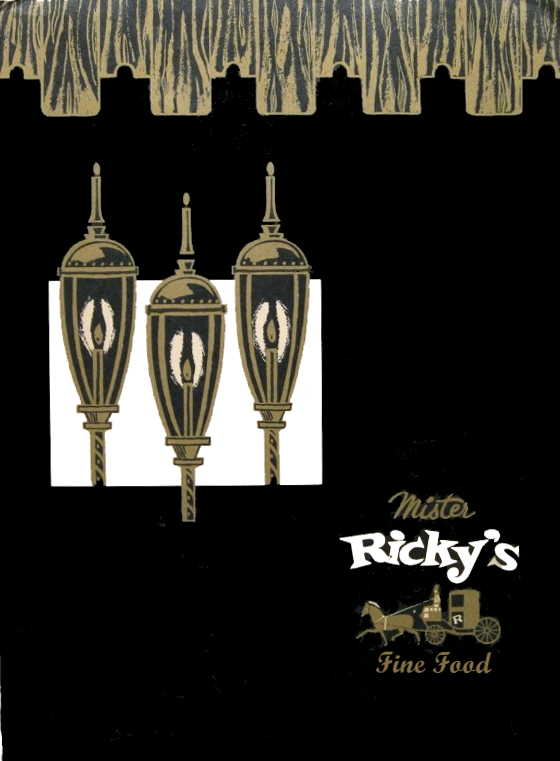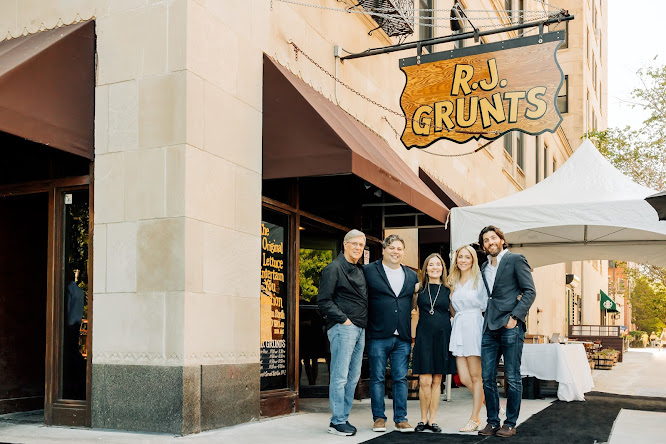For years Melman did not get along with his father. "I would have worked somewhere else, but I didn't feel I had a lot going for me," he said. "I flunked out of college — well, I would have flunked out if I hadn't quit first — so I worked for my dad behind that cash register."
He had one dream: He wanted to be a partner in Mr. Ricky's. "That would have been it for me," Melman said. "That's all I wanted out of life."
He managed to save some money, and one day he asked his father and his father's partner if he could speak with them. He said he would like to join them — if only in the most minor way — as a partner in Mr. Ricky's. He was, after all, Ricky.
"My father told me no," Melman said. "He said I was welcome to continue working there but wasn't ready to help run the place.
"Come to think of it, even though I worked the cash register, my Dad would never let me total it up at the end of the day. He just wouldn't let me do it. So Melman quit. (NOTE: Stew Colton claims he knew Rich Melman, and Rich told Stew that his Dad fired him.)
Rich and his friend, Jerry A. Orzoff, opened R.J. Grunts (Rich [and] Jerry [are] Grunts) at 2056 North Lincoln Park West, Chicago, in 1971. Then Melman and Orzoff incorporated the business as "Lettuce Entertain You Enterprises, Inc." (LEYE).
After one year, Rich and Jerry pay off R.J. Grunts. In 1972, Jerry talked Rich into retiring and moving to Los Angeles with him. After four months in Los Angeles, Rich is bored with retirement and anxious to return to Chicago, and he never thinks about retirement again.
The success of R.J. Grunts marked the beginning of Lettuce Entertain You Enterprises, Inc.
 |
| R.J. Grunts Salad Bar. |
In 1973 new ideas and concepts were created, including the debut of Fritz That's It!
Fritz That's It! was located at 1615 Chicago Avenue in Evanston, next door to the North Shore Hotel. They had an excellent salad bar that included good Caviar. New Year's Eve was packed, usually an hour and a half wait, but the drinks and menu were half-price. There was no direct access between the hotel and Fritz That's It!
Fritz That's It! was followed by the Great Gritzbe's Flying Food Show in 1974, Jonathan Livingston Seafood in 1975, and Lawrence of Oregano in 1976. Melman's style evolved with each new restaurant, and he thrived on the challenge.
Having mastered the off-beat casual restaurant style, Melman directed his attention and energy toward the world of fine cuisine when he reopened the famous Pump Room in the Ambassador East Hotel on Chicago's Gold Coast in 1976, which initially opened in 1938.
 |
| The force behind the original Pump Room was Ernest Byfield, right, with Humphrey Bogart and Lauren Bacall. The Bogarts were the Ambassador East Hotel and Booth One regulars, even honeymooning in an upstairs suite. |
In 1979, Melman decided to expand to the Chicago suburbs and opened Bones in Lincolnwood, Illinois. In 1980, LEYE took the popular R.J. Grunts, added a more contemporary look, and opened a second location in Glenview, Illinois.
In 1980, Melman and Chef Gabino Sotelino traveled to France, where they insisted on bringing contemporary French cuisine to Chicago. This led to the opening of Ambria in the Belden-Stratford at 2300 North Lincoln Park West in Chicago. The success of Ambria inspired additional trips to Europe to study food and style.
As a result of such visits, LEYE opened Un Grand Café, a French-styled bistro at 2300 N Lincoln Park West in Chicago, and the sophisticated Italian restaurant, Avanzare. In 1983 Melman opened a Gino's franchise unit in Rolling Meadows. Also opened in 1983 was Rupert's Club 33 at 1701 Golf Road, Rolling Meadow.Ed Debevic's at 159 East Ohio Street, Chicago, opened in 1984 as a retro-themed diner. It closed in 2015. Then came Shaw's Crab House in 1984 and The Blue Crab Lounge in 1985. In 1986 a Spanish tapas and small plate restaurant, Cafe Ba-Ba-Reeba! opened along with an upscale dining experience at Everest the same year. Let's not forget the southern Italian trattoria, Scoozi!, also opened in 1986.
A new innovative Mexican, Hat Dance, opened in 1988, then Tucci Benucch opened at 900 North Michigan Avenue, Chicago, in 1988. Then and its cousin, Tucci Milan, in 1989.
 |
| Bub City's River North Location. |
The first Bub City restaurant opened in 1989 at 901 West Weed Street in Chicago and closed in the late 1990s. A new Bub City reopened in 2012 in the River North neighborhood at 435 North Clark Street, Chicago.
The Eccentric at 159 West Erie Street, Chicago, opened in 1989 and is best known for high-profile partner Oprah Winfrey. Closed on Friday, September 29, 1995.
The creation of the Frequent Diner Club Program in 1991 was a game-changer in the restaurant industry, as one of the first loyalty programs of its kind.
In the 1990s, LEYE opened The Original A-1 Border Beanery Bail Bonds & One Hour Perms in Chicago in 1990, Maggiano's Little Italy in Chicago in 1991 and Oak Brook in 1992. Papagus Greek Taverna in Oak Brook in 1991 featured Grecian delights and Mezedes amidst the friendly surroundings of a rustic taverna, and Big Bowl in Chicago's River North district in 1992, an Asian cafe featuring simple, fresh dishes under $10. Melman opened the Corner Bakery, a quick, casual restaurant chain geared towards downtown lunches, and M-Burger, a gourmet burger stand.
Tuchetti's opened in December 1992 at 4400 Fox Valley Center Dr., Aurora, Illinois. Specializing in "old-fashioned" Italian cooking, which is red-sauce Italian food that most of us grew up with. But it's not like the red sauce that every public and private Elementary and High School lunchroom served. The one that leaked orange oil; oh, and don't touch the orange oil. It'll stain your finger for 3 days.
In the spring of l993, Melman introduced two new innovative dining concepts with the opening of foodlife and MityNice Grill, located in Chicago's Water Tower Place. Foodlife, a revolutionary food hall, offers an abundant choice among 13 restaurant kiosks. MityNice Grill, located at the east end of foodlife, was a comfortable neighborhood grill with the decor and feel of the 1940s, accompanied by a diverse yet simple menu.
At the end of 1995, LEYE opened two new distinctive restaurants. Brasserie Jo opened in September at 59 West Hubbard Street, Chicago, as an authentic, lively French brasserie. They offered traditional French cuisine and an extensive selection of European cocktails.
Wildfire, which features quality steaks, chops, and seafood in a warm and stylish environment, opened in December 1995.
In 1996 Melman opened its first Chinese restaurant in January, Ben Pao, which, loosely translated, means firecracker. In December 1998, Wildfire opened in Oak Brook and a Wildfire in Lincolnshire in 1999.
In March 1999, Bones Restaurant (opened in 1979) in Lincolnwood reopened the rebranded restaurant as L. Woods Tap & Pine Lodge, a nostalgic Northwoods Supper Club with a log cabin feel. Ribs seem to become a conversation every time anybody says "L. Woods."

 |
| L. Woods Rack of Ribs. |
Several exciting new concepts opened in 1999, including a fine-dining restaurant, Tru, with Chef Partners Rick Tramonto and Gale Gand, and Vong, with partner Jean-Georges Vongerichten.
In April of 1999, Rich Melman and Gerard Centioli announced the formation of ICON, LLC (ICON), establishing partnerships with established restaurant icons for the expressed purpose of multi-unit expansion and development.
In 2000 LEYE opened Joe's Seafood, Prime Steak & Stone Crab in Chicago, styled after their iconic Miami restaurant. Mon Ami Gabi opened its third location in the Oakbrook Mall.
Shaw's expanded to the Streets of Woodfield in Schaumburg with Shaw's Crab House and Red Shell. In early 2001, LEYE expanded into Chicago's Loop area with a brand new restaurant concept called Petterino's, located in the Goodman Theater building featuring prime steaks, fresh seafood, and classic specialties in a 1940s atmosphere.
Jean-Georges Vongerichten's Vong-Chicago was revamped into Vong's Thai Kitchen with a lower-priced menu and a vibrant atmosphere.
As the success of Wildfire continued, in June 2003, a new location was opened in Schaumburg, Illinois. Later that summer, LEYE developed a new fast, casual concept called Wow Bao, located at Chicago's Water Tower Place shopping center entrance. Wow Bao specializes in Asian-influenced savory steamed buns, nourishing broths, crunchy salads, specialty sodas, and teas. At the end of the year, Wildfire opened its sixth location in Glenview in December.
The second Wow Bao in the Chicago Loop location started off in 2007. In March, Wow Bao opened for breakfast, lunch, and dinner, offering breakfast bao, entrée salads, dumplings, and potstickers.
Frankie's Fifth Floor Pizzeria opened in the 900 North Michigan Avenue Shops offering Sardinian and Tavern Pizzas. In 2008, Frankie's Scaloppine opened next to Frankie's Fifth Floor Pizzeria, a neighborhood Italian restaurant with style featuring chicken, veal, and vegetable scaloppini.
The Reel Club at Oakbrook Center opened in 2008, with Sushi and fresh seafood shipped in twice daily. They closed in September 2018.
Rich Melman's sons, R.J. and Jerrod, opened Hub 51 in 2008, an American concept located in River North. Hub 51 duals as a restaurant/bar skewed to the young and hip with great food, drinks, and music. Hub 51 also opened in O'Hare Terminal 5.


L2O (Lake to Ocean) opened in Lincoln Park in 2008 and closed in December 2014.
 |
| L2O Interior. |
The Paris Club Bistro & Bar opened in 2011 at 59 W Hubbard Street, Chicago. It quickly became one of Chicago's hottest nightclubs and celebrity hangouts, playing host to the biggest DJs and performers worldwide, including Justin Bieber, Calvin Harris, Snoop Dogg, Diplo, Chance the Rapper, and others.
Saranello's in Wheeling also opened in 2011.
Rich Melman won the James Beard Outstanding Restaurateur Award in 2011.
The RPM Restaurant brand was born in 2012 with the opening of RPM Italian in Chicago, with celebrity couple Bill and Giuliana Rancic as partners.
Intro opened in 2012, presenting Modern Chinese and Dim Sum on Sundays. Closed in 2017
Lettuce Fly was created with the opening of Big Bowl in 2013 at O'Hare International Airport's Terminal 5.
The first location of Beatrix opened in River North in 2013. The neighborhood restaurant and coffeehouse had three locations in Chicago and one in Oak Brook, IL. It also expanded to include Beatrix Market, a grab-and-go concept highlighting Beatrix's best.
LEYE opened Joe's Live in Rosemont, Illinois, in 2016, a concert and music venue.
Studio Paris Nightclub opened in 2016 at 59 West Hubbard Street, Chicago, but abruptly closed in February 2019.
Naoki Sushi opened in 2016 and closed in December 2019.
Lettuce Entertain You opened Seaside in 2017, which became the organization's first virtual restaurant. Additional virtual concepts opened in 2020 due to the COVID-19 pandemic, including Ben Pao, Vong's Thai Kitchen, Coastal Soups & Salads, and others.
RPM Seafood, Pizzeria Portofino, and RPM Events open in 2019, overlooking the Chicago River, featuring four floors of outdoor dining space.


















































